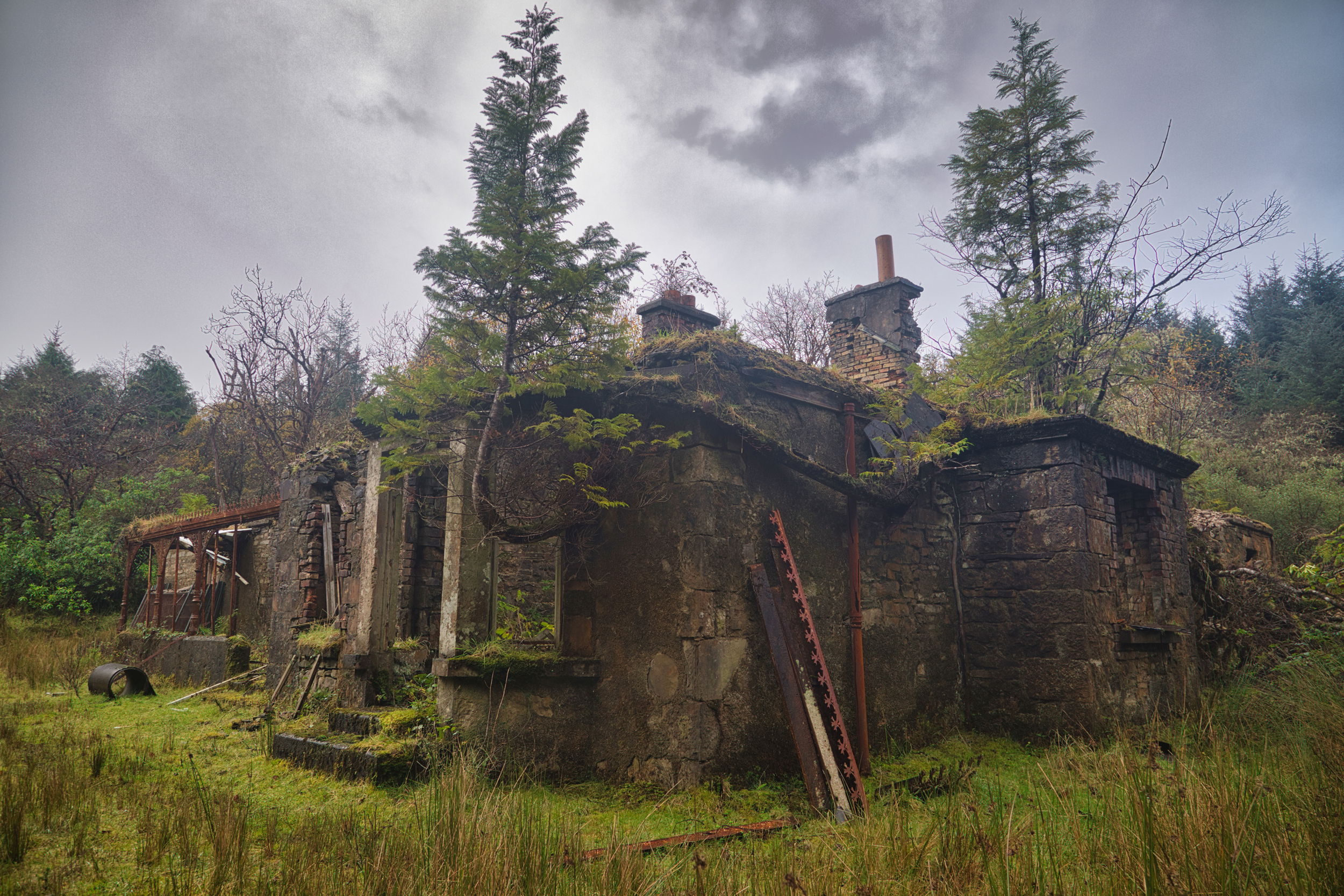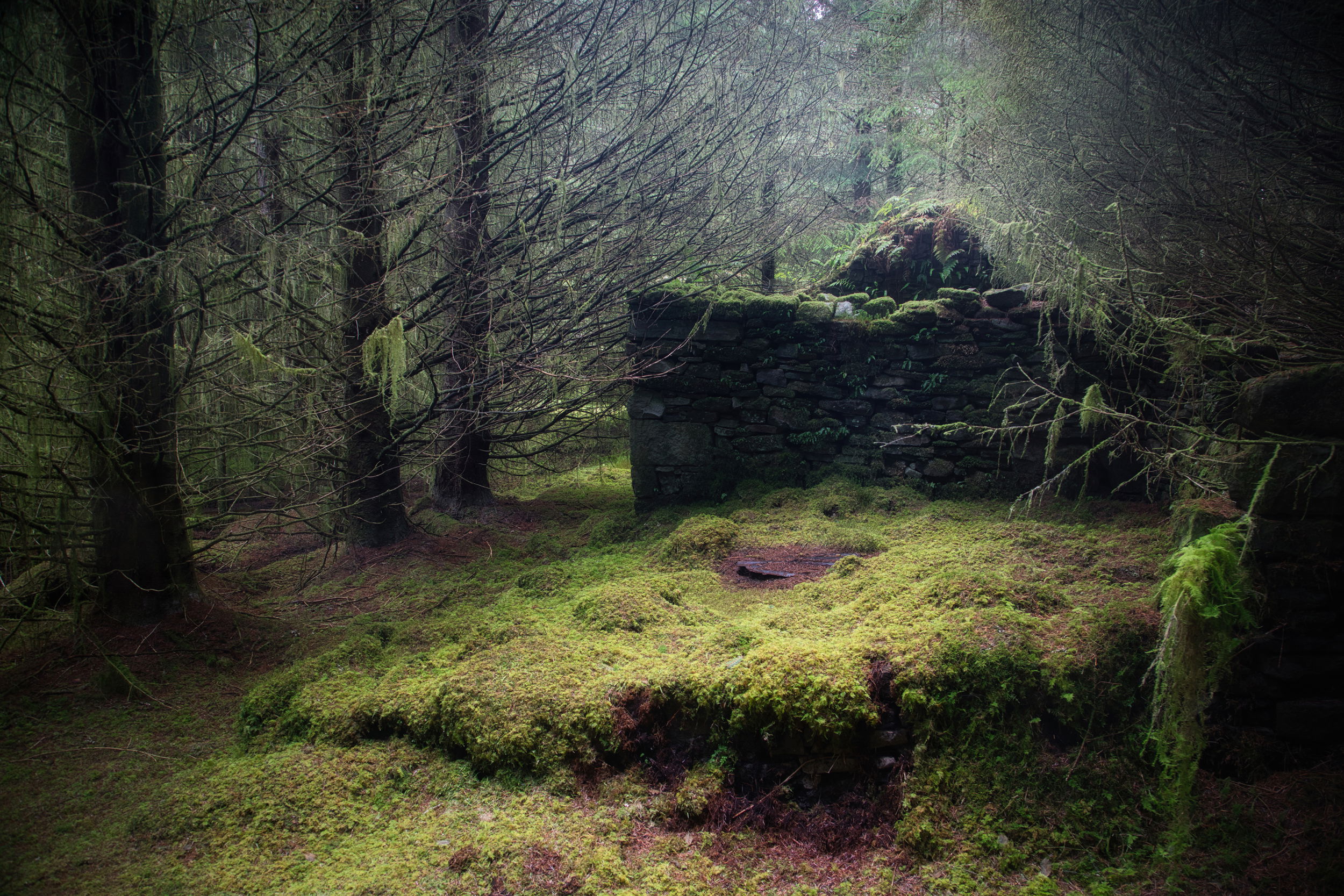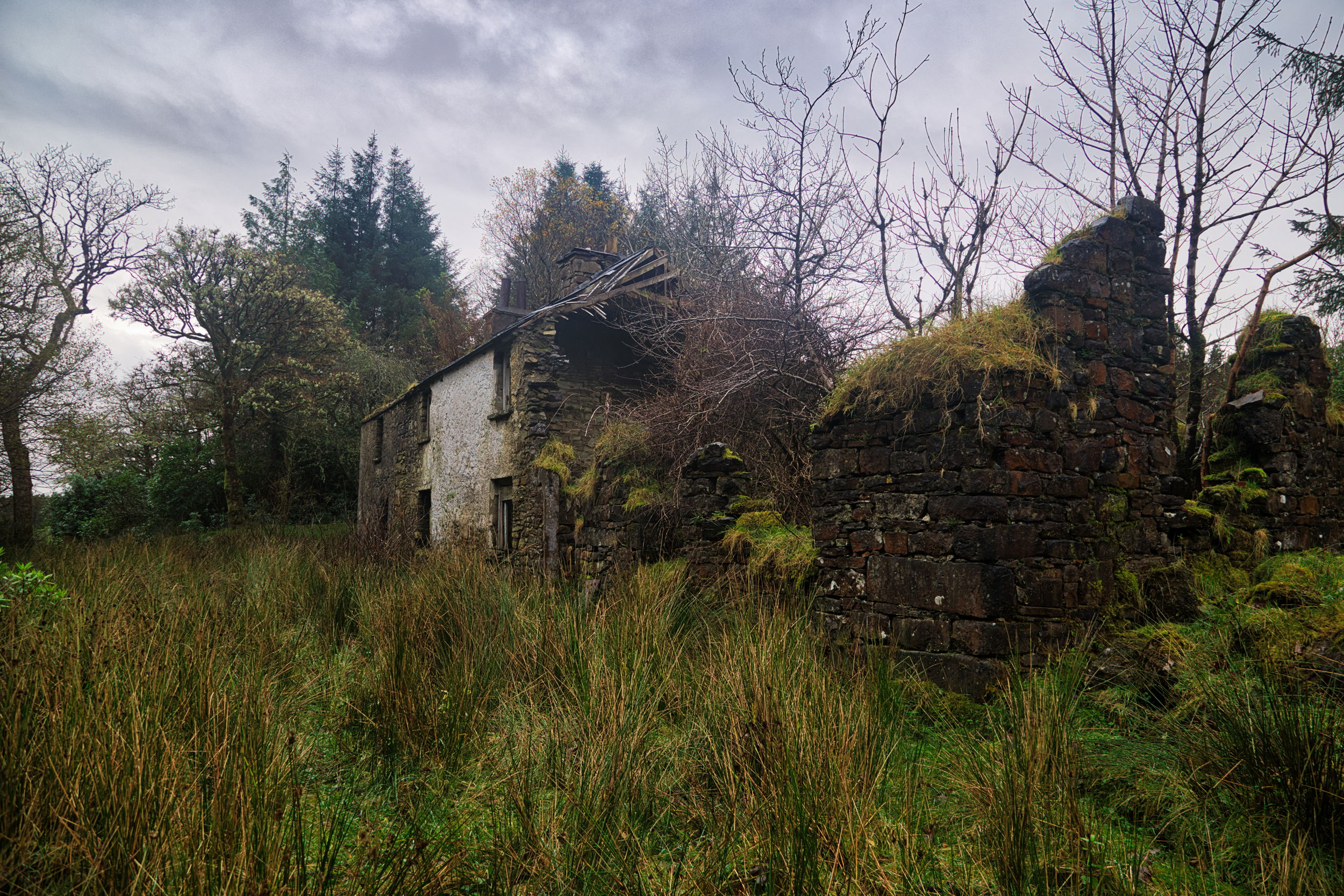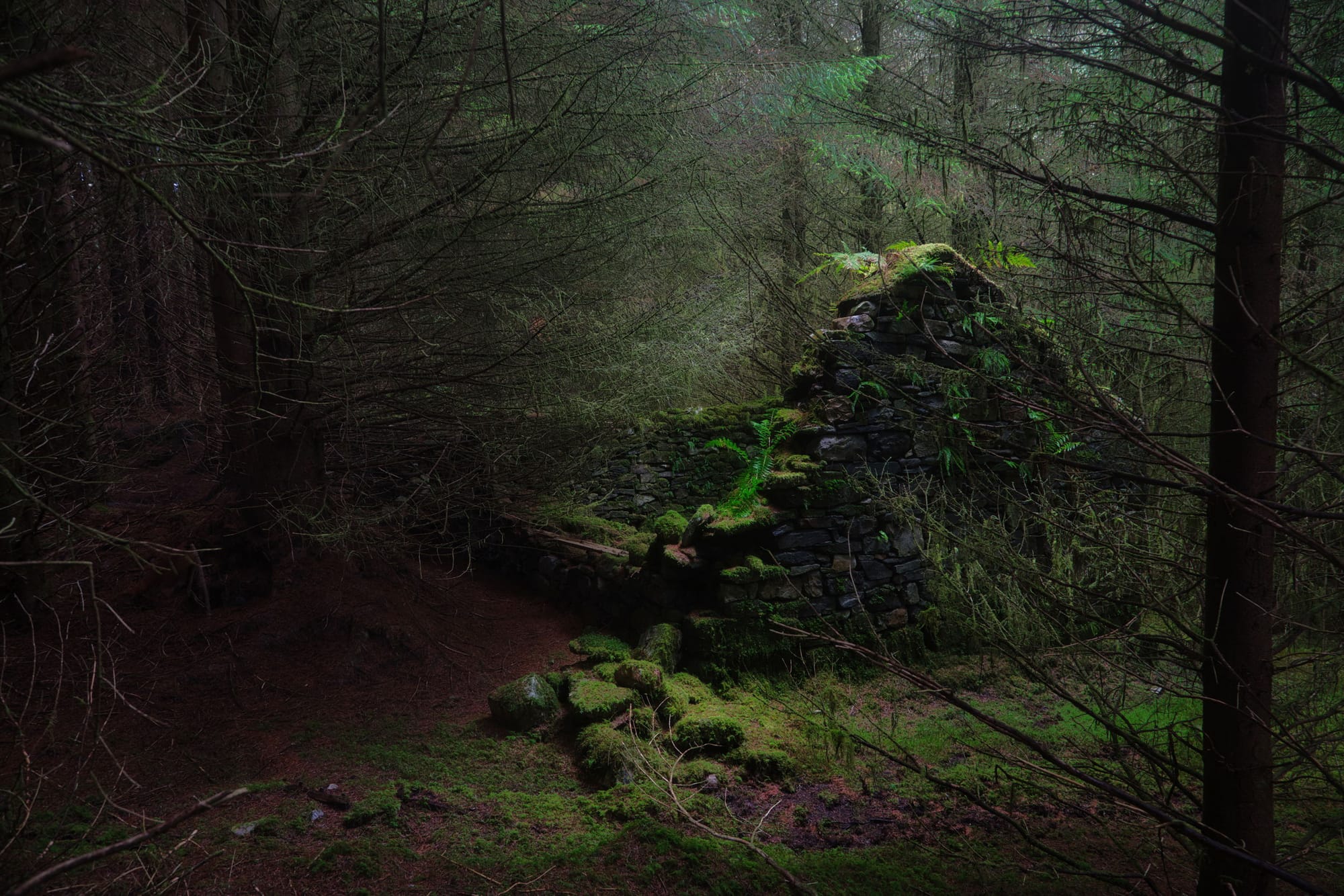Sheskin, Navigating the Intersection of Technology and the Natural World 𖣘 ♻️ 🌿
“When dynasties are dead, as die they must, When sorrow is silent and red swords are rust, When man is a memory and his dreadful dreams are dust, I am Corslieve. Nephin and I keep trust: True to the untrue, to the unjust.”
Terence Hanbury "Tim" White (29 May 1906 – 17 January 1964)
- He came to Sheskin Lodge in 1939 and stayed for a while during WW2 -

Motivated by my desire to capture the spirit of historic, abandoned buildings and the stories they may tell, I traveled to Sheskin, a quaint gem nestled in north Mayo this past weekend. This excursion was driven by my fascination with the ancient building remains scattered throughout the area—some visible, while others lie hidden deep within the expansive Sheskin forest.

Located alongside the Western Way, today, Sheskin Lodge is in ruins. The original lodge was constructed by the MacDonnell family from Carnacon, who fought with the French in 1798. The lodge, which was purchased and completely restored by the Jameson family (famous for manufacturing whisky) towards the end of the 1800s, was primarily used as a hunting and shooting station.

Boundary walls around the lodge now take on an eerie look as moss and ferns slowly take over the landscape.

Beside the lodge, but laid back a little in the forest, is the cart house that still stands and shows off its nice stonework.

The lodge's front garden has evolved over time from its original grandeur, which included a massive monkey puzzle tree that sadly is now gone, to something equally amazing.
As I neared the forest, a stark contrast greeted me: the newly constructed Sheskin Wind Farm road. For those familiar with the trail that once passed through this enchanting landscape, the shift was remarkable. The wide, gravelly road stretches approximately 7 km into the heart of the forest, leading towards the electricity substation and replacing what was once part of the trail of the old Sheskin forest path. This was a clear indication of how the landscape is evolving, marking a new chapter in the region’s relationship with renewable energy.

Gazing into the heart of Sheskin Forest, the wind turbines stand tall, demonstrating the amount of power they are capable of producing.
As regular readers of my blog know, I hold a deep and ongoing concern about how we balance the wonders of nature with the encroachment of modern technology. In recent years, wind turbines have emerged as prominent features in our landscapes, stirring mixed emotions among those who witness their towering presence. Whether one loves them or resents them, there’s no denying that they are here to stay.

The old, deserted homes, tucked away in the Sheskin forest, gradually return to their original shape as ivy and moss begin to cover them.
This week, at the COP29 climate conference in Baku, Azerbaijan, a new report shed light on Ireland's journey in addressing climate change. It's interesting to hear that Ireland's international ranking in climate performance has improved significantly over the past year. This positive shift underscores the commitment of the nation to tackle environmental challenges and embrace sustainability. One of the key factors contributing to this improved ranking is the substantial increase in Ireland’s renewable energy capacity.

Having stood for more than 170 years, these homes have witnessed many changes throughout the years.
On this particular day, my journey took me through the captivating vista of Sheskin as I aimed to locate and photograph the remnants of old ruined dwellings, while also exploring the intriguing relationship between burgeoning technology and our precious natural environment. This region is not only celebrated for its breathtaking views but also for its rich biodiversity, housing a variety of wildlife and stunning flora that make it ideal for immersing oneself in the natural world.

Wind turbines weren't the first structures to disrupt the pristine terrain, as seen by the gas warning posts scattered over a section of Sheskin.
The moment I stepped onto the road, a complex mix of admiration and contemplation washed over me. The wind turbines, with their sleek geometry, reached high into the dark sky, forming a striking contrast against the lush green backdrop of towering trees. Their imposing presence was hard to ignore, yet I couldn’t help but marvel at the potential they hold for sustainable energy production—a vision for a greener future.

As time passes, nature tends to regain its own. Here, the foliage is overtaking yet another of the forest's ancient remains.
Armed with my camera, I embarked on the journey along the winding road, my goal clear: to document the striking contrast between the magnificent turbines and the verdant, surrounding trees. Occasionally, I would veer off the road to explore remnants of the past—crumbling ruins standing silently, whispering tales of another time.

The view from the new road looking into Knockmoyle Nature Reserve.
The reserve is a lowland blanket bog in a Special Area of Conservation. The site has a rich flora owing to the lack of burning or grazing, with well-developed cover planting. An unusual feature of the site is small areas of rare mosses. Amongst other species recorded here are black bog rush, bog cotton, deer sedge, purple moor grass, marsh saxifrage, wild angelica, and marsh arrowgrass.
These structures, once vibrant and full of life, now serve as poignant reminders of a bygone era. They evoke a multitude of questions about the changing landscape and our quest for greener energy solutions. The towering turbines are not merely a sign of progress but symbolize our ambitious drive towards sustainability, harnessing nature’s power in ways that feel both promising and disconcerting.

Window to the past !
“This juxtaposition of the old and the new raises important questions about how we navigate the intersection of technology and the natural world.”

This house is located near the lodge and is depicted on Griffith's valuation maps. It has a lengthy history, as Richard John Griffith completed his property assessment in Mayo in 1857.

Same house, but this time looking up the drive.
In conclusion, my day in Sheskin reinforced the notion that progress often comes at a cost. As we advance towards a future that embraces renewable energy, we must also remain mindful of the natural treasures that ground us in our history. This delicate balance between honoring the past and embracing the future is imperative for a sustainable coexistence, and it is a conversation worth having as we navigate these uncharted waters.

Numerous more abandoned ruins may be seen scattered around the place, indicating that, despite its remoteness, the area was formerly rather populous.


I went wandering in the woods
Where the tallest trees have grown
When I came upon an old abandoned house
With tall, ivy covered walls of stone.
The first stanza in a poem by Stephanie Tiner

Carpe Diem